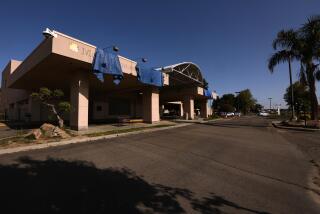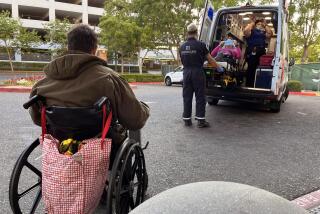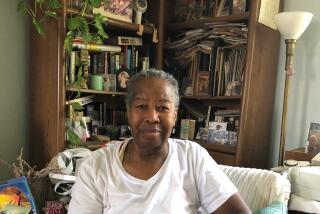Redding’s Spotlight Turned Into an Unwanted Glare
- Share via
REDDING -- Ever since the Gold Rush era, this town has been accustomed to economic cycles of boom and bust. When the last big moneymaker, the timber industry, faded away, the only constant seemed to be its prime location -- at the center of the so-called Golden Circle, which attracted hikers, fly fishermen and other outdoor enthusiasts to Mt. Shasta, Lassen Peak’s active volcanic area and other pristine wilderness nearby.
But in the last decade, the town became a magnet for a different kind of visitor. Patients from as far away as Sacramento, the Oregon border and eastern Nevada have descended on Redding, drawn by Redding Medical Center’s growing reputation as a leading center for heart surgery.
In 1993, the 238-bed hospital, owned by Tenet Healthcare Corp., embarked on an ambitious plan to build a heart institute. Two years later, a five-story medical wing rose up in the center of town, intensifying a rivalry with Redding’s other hospital, Mercy Medical Center, and setting up what would become an economic boon for Tenet but also for the town.
The two hospitals “are a real key component of the economy here,” said Doug Latimer, Shasta County’s chief administrative officer.
But now, Redding Medical has put an unwanted glare on this town of 88,000 on the Sacramento River, which appears deeply divided about the hospital and the two doctors who built up its cardiac practice and now are being investigated for allegedly performing numerous unnecessary procedures and surgeries.
Since a raid of the hospital by 40 federal agents last week, dozens of former patients of Dr. Chae Moon and Dr. Fidel Realyvasquez are wondering whether they were unnecessarily operated on. But other patients and medical staff have come to their defense, holding a candlelight vigil and providing equally stirring testimonials about how Moon, the hospital’s director of cardiology, and Realyvasquez, chairman of cardiac surgery, saved their lives.
One thing most everyone will agree on is that for years there have been whisperings in the community and elsewhere about whether Redding Medical was being overly aggressive with heart procedures. In fact, in recent years HMO firms and some medical groups pulled out of the Redding area, saying they were losing too much money because the filing of health-care claims was off the charts.
“Redding is the highest cost of care per population in all of California,” said Steve McDermott, chief executive of Hill Physicians Medical Group. McDermott said his doctors group pulled out of Redding at the end of last year, after losing almost $1 million last year serving 22,000 HMO members there.
Blue Shield of California said it would stop providing HMO service to members of the California Public Employees’ Retirement System in the Redding area as of early next year. According to a 2000 report prepared for the California Healthcare Foundation, the Redding area had the highest rate of bypass surgeries in California, at 13.55 procedures per 1,000 enrollees -- more than double the statewide average.
But others in Redding, particularly those supporting the two doctors, say there are reasons for the high numbers. They say Redding has a large senior community, including many retired people with a high incidence of smoking. And there’s been a “tremendous influx” of retirees to the area, said Latimer, the Shasta County official.
Latimer noted that Redding Medical and Mercy Medical, which is owned by nonprofit Catholic Healthcare West, have contributed mightily to the region’s tax revenues, jobs and philanthropy and also provide some of the best wages in the region. State figures show that more than 11% of the Redding payroll workers overall are employed in the health services area, compared with 7% statewide.
Mercy Medical also has a cardiology department, but the hospital’s profit is just a fraction of Redding Medical’s. And some doctors say a bitter rivalry between the hospitals is behind much of the criticism against Redding Medical and the two doctors.
“There have been sour grapes,” said Dr. Shishir Dhruva, an anesthesiologist at Redding Medical Center who has worked with Moon and Realyvasquez. “It’s like two hamburger joints on the same street, and one is selling four times more.... That’s what’s created this sort of atmosphere.” He added that the higher number of coronary procedures reflects Redding Medical’s early adoption of new technology.
In 1991, for example, Moon is said to have been the first doctor in Redding, and one of the first in Northern California, to use a cold laser treatment for unclogging blocked arteries. His apparent eagerness to be one of the first to master state-of-the-art heart surgery tools dovetailed with the plans of Redding Medical and Tenet to establish the facility as one of the premier heart hospitals in the nation.
Every breakthrough development and Moon’s place in being among the first to use it were chronicled in Redding’s hometown newspaper. On parallel tracks, Tenet’s ambitious expansion of Redding Medical Center continued apace with the creation of the heart institute in 1993, the five-story medical wing in 1995, and an addition in 2002 that expanded the hospital by nearly two-thirds in size.
Today, Redding Medical Center is a thriving medical center with a strong local marketing campaign replete with billboards, advertisements and even a “put a little love in your heart” campaign in 2001. At the entrance, patients and visitors are greeted with free peppermints and chilled bottled water. A Yamaha player piano plays softly in the background in the lobby, where the private and soundproofed patient consultation rooms are located.
Emergency room nurse Richard Caylor had just finished a 12-hour shift when he was interviewed at the hospital. “We are proud of these doctors and our reputation as one of the top 190 heart hospitals. I’d recommend them to anyone. I’d bring my own family here.”
Around town, there were plenty of people eager to speak up for Moon and Realyvasquez.
At the Home Depot in Redding, cashier John Volk, 53, is convinced that the doctors saved his life last year when Moon advised and Realyvasquez performed triple bypass surgery.
So is Volk’s wife, Mary. She knew that her husband had high blood pressure, but was not overly concerned about a curious trait of her husband’s, falling asleep in the middle of conversations at family gatherings.
Both were shocked when Moon gave Volk a test, then announced brusquely that there was nothing he could do and that immediate bypass surgery was necessary. Volk had gone in for a routine stress test and had expected nothing serious, but now he declares himself a satisfied customer. Volk, a powerfully built, barrel-chested man, is much more vigorous now -- or “peppy,” as his wife describes it.
Just about everyone in town seems to know someone or is related to someone who was operated on by Moon or Realyvasquez.
Moon, born in Seoul in 1947, has lived in Redding since 1979. He has been very active in the community, giving free lectures on medical care and cutting-edge technology, endowing a science scholarship for Shasta High School graduates and organizing fund-raisers for the Redding Symphony.
“He’s really given back to this community,” said Redding resident Betty Prince, 64.
Realyvasquez, born in La Union, Mexico, in 1948, did not move to the Redding area until 1990, but he more quietly established the similar tradition of community involvement, most notably donating 50 original Ansel Adams prints to Redding’s new Turtle Bay Museum.
Attempts to contact Moon and Realyvasquez for this report were unsuccessful.
Dugan Barr, a Redding attorney who represents Father John Corapi, the priest who complained to the FBI about being pressured by Moon to accept an unnecessary surgery, said he wasn’t surprised that the doctors have so much support.
“These doctors have done a tremendous amount of good, but they have also done a tremendous amount of unnecessary surgery,” Barr said. “When they weren’t busy doing surgeries that needed to be done, they were busy with surgeries they didn’t need to do.”
White reported from Redding and Lee from Los Angeles.
More to Read
Sign up for Essential California
The most important California stories and recommendations in your inbox every morning.
You may occasionally receive promotional content from the Los Angeles Times.















